Introduction |
Typical Patterns |
Hazard Awareness |
Statistics |
Albuquerque Maps |
Resources |
Albuquerque Metro Maps
|
|
The maps below show the spatial distribution of monsoonal precipitation across Albuquerque for various years. Precipitation totals encompass the dates of June 15th through September 30th. Since the only official stations are the Albuquerque Sunport and a handful of cooperative observers, these maps could only be possible thanks to the dedicated members of the Community Collaborative Rain, Hail and Snow (CoCoRaHS) Network. These volunteer observers help fill in the data gaps across Albuquerque, Rio Rancho, Corrales and Placitas. However, there are still many areas in southwest Albuquerque that are not represented well due to a lack of observations. If you want to be a CoCoRaHS observer, please visit the CoCoRaHS webpage!
|
|||||||||||||||||||
| Normal rainfall at the Albuquerque Sunport for the period of June 15 through September 30th is 4.48 inches. In 2025, the Albuquerque Sunport reported 3.07 inches of precipitation. | |||||||||||||||||||
|
The immediate map below represents the 2025 Monsoon precipitation totals across the metro area. It's clear that much of Rio Rancho, the Albuquerque west side and most areas south of I-40, including the Albuquerque Sunport, missed out on heavier rainfall totals. Nonetheless, there were a few flash flood events across the metro. The first occurred during the overnight hours going into July 3rd when 1.5 to 2.5 inches of rainfall on the Albuquerque east side produced dangerously fast flows on area arroyos. Three people were swept away in the floodwaters, but unfortunately, only two were rescued safely. Similar amounts also occurred across portions of Rio Rancho and dirt and debris was washed over the roadway near Northern Blvd and Calor Road. Other heavy rainfall events in July included: July 18th when northwest portions of Albuquerque received close to 1 inch; July 22nd when areas from the Sunport eastward across southeast Albuquerque received between 0.50 and 1 inch; and July 23rd when 1 to 2 inches of rain fell across the North Valley causing flooding on the eastbound lanes of Paseo del Norte at Rio Grande Blvd. A business on 4th street in the Los Ranchos de Albuquerque neighborhood as well as a nearby residence had floodwaters entering the building. August was very quiet across much of the metro area with most locations receiving less than an inch of rainfall. The exception was near Placitas which had well over 2 inches of rain. September brought several rounds of light rainfall, except on September 28th. On that evening, very heavy rainfall fell across Kirtland AFB housing. One personal weather station recorded over 2 inches of rainfall in one hour's time. Several parked cars were submerged in the floodwaters. |
|||||||||||||||||||
 |
Key
|
||||||||||||||||||
| 2025 | |||||||||||||||||||
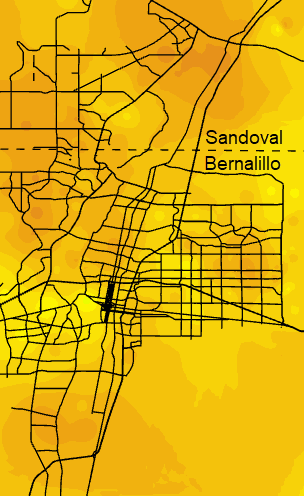 |
The 2024 monsoon started with a moisture rich airmass invading the state in mid to late June. Several days of precipitation occurred and June ended up being the 7th wettest for the Albuquerque Sunport. On June 29th, 1.48 inches of rainfall occurred with a severe storm that brought flash flooding and damaging winds to much of the city. Some areas of the city received over 2 inches of rain. Underpasses and low lying intersections in downtown were inundated with deep floodwaters. An SUV and public transit bus were partially submerged under the water. The Albuquerque Fire Department also performed seven water rescues in arroyos across town. The 1.48 inches of rain was 0.01 inches more than all of July's rainfall. July wasn't all quiet though. On July 20th parts of the far west side and north central Albuquerque received around one inch, then on the 21st, the South Valley received between 1 and 1.5 inches. August was pretty dry for the most part but on August 9th, there was widespread rainfall amounts between one half and one inch, though on the southeast side, between 1 and 1.5 inches of rain fell. This caused flash flooding once again. Two people and a dog were swept away in flood waters in the arroyos, and unfortunately one person did not make it. September was very dry as well, with only 0.06" of rain falling at the Sunport. | ||||||||||||||||||
| 2024 | |||||||||||||||||||
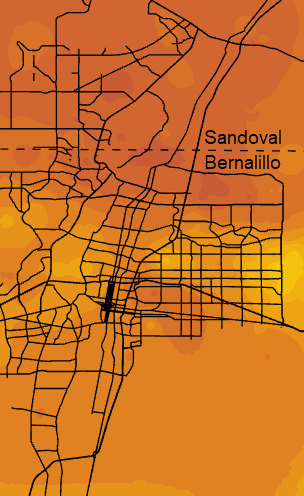 |
2023 was the worst monsoon for the metro area since 2020. Most locations only received between one and four inches of precipitation, though there were spots that received less than an inch! Portions of Rio Rancho, the Albuquerque North Valley and the far Northeast Heights were among those areas that struggled to reach the one inch mark. When it did rain, it dumped, and you can pick out these events on the map. On September 18th, a severe storm brought heavy rain and hail to areas near and just east of the Rio Grande Nature Center. On September 13th, thunderstorms brought heavy rainfall to areas near the Petroglyph National Monument and Taylor Ranch as well as near the Albuquerque Sunport. In fact, the 0.73 inches measured at the Sunport on this day was the greatest one day total this monsoon. On August 26th, the far west side of Albuquerque received up to 1.50 inches. Perhaps the most memorable monsoon day for most was August 8th. Two rounds of thunderstorms impacted east central Albuquerque, dropping between 1.00 and 2.50 inches of rain in less than two hours. Flash flooding impacts were numerous. Arroyos filled quickly, and two people were swept away in the flood waters but were fortunately able to self rescue. Additionally, due to the amount and velocity of the water, the I-40 channel sustained damage at San Pedro, closing two lanes of I-40 for several days while emergency repairs occurred. | ||||||||||||||||||
| 2023 | |||||||||||||||||||
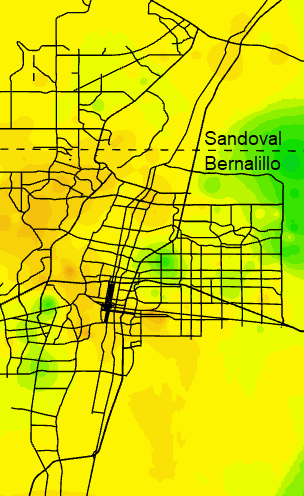 |
The 2022 monsoon started with several days of light to moderate rainfall in June. Very little lightning was observed during this time, but most areas in the metro picked up between 2 and 3 inches of much needed rain. In July, rainfall amounts were much spottier, with many locales only picking up a half inch or less of rainfall. Thunderstorm activity picked up again in August and lingered through September. In total, rainfall amounts across the metro generally ranged from 4 to 6 inches. However, amounts up to 8 inches were noted across northeast Albuquerque and spotty locations in the metro. Fortunately, there was no reported flash flooding during the season within the metro area. |
||||||||||||||||||
| 2022 | |||||||||||||||||||
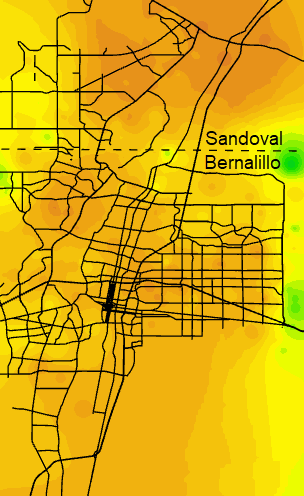 |
In 2021, most areas across Albuquerque received between 3 and 5 inches of rainfall, except for areas near the foothills, which received up to 8 inches. The Rio Rancho and Bernalillo areas were notably drier, once again, with between 2 and 3 inches of rainfall reported. Nonetheless, it was an active monsoon with all areas reporting more rainfall than in 2020. There were a whopping 32 days where the Albuquerque Sunport recorded measurable rainfall, however, only 2 of those days (July 31st and September 30th) recorded over half an inch. While rain at the Sunport was rather tranquil, it was not so for other parts of the city. On July 20th, a thunderstorm across eastern Albuquerque with rainfall rates of 3 to 4 inches per hour dropped copious amounts of rain that quickly filled drainage systems. Five people were swept away in arroyos and sadly, only two were rescued. Only a week later, another heavy rain producing thunderstorm filled arroyos with water once again and another two people were swept away. Unfortunately, only one person was rescued. This was the deadliest monsoon in the Albuquerque area in recent memory. Areas in nearby Placitas also had several days with heavy rainfall at the end of July. Roads and drainage ditches were flooded. |
||||||||||||||||||
| 2021 | |||||||||||||||||||
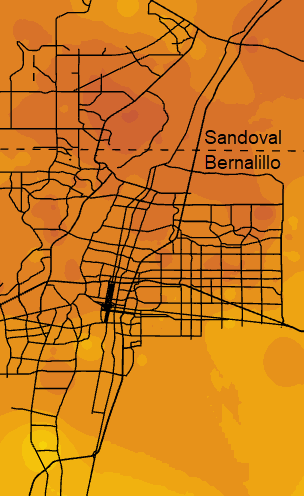 |
In 2020, most reporting stations received between one and four inches of rainfall, well below climatological averages. Instead of rain, this monsoon season was often met with smoke and haze that drifted overhead from wildfires in California, Oregon, Washington and Colorado, especially in August and September. Looking at the maps below, 2020 was the driest monsoon in Albuquerque since 2011 or 2012, depending on the exact location within the metro area, and portions of Rio Rancho and Corrales were the driest over the last 10 years. Surprisingly, there was seven consecutive days of measurable precipitation at the Albuquerque Sunport, from July 22nd through July 28th, though no one day measured over 0.28 inches. Though this stretch of slow and steady rain was beneficial, we needed quite a bit more days like this than what we received. In fact, the highest one day total at the Sunport was 0.37 inches on September 9th. However, this precipitation came with a winter-like storm system, rather than from monsoonal flow. Some areas across the mountains and northeast NM actually had measurable snow! The good news is that no flash flooding occurred within the metro area this monsoon season. Though portions outside of the metro, in Socorro and Santa Fe counties, saw flash flooding on July 26th. |
||||||||||||||||||
| 2020 | |||||||||||||||||||
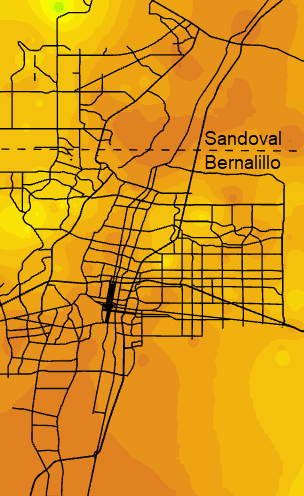 |
In 2019, most reporting stations received between 2 and 5 inches of rainfall. The earliest heavy rain event occurred on July 6th, when a few observers on the east side of Albuquerque reported over one inch of rain. Most of this rain was welcome, however, after a dry June. One July 16th, portions of far northwest Albuquerque received between one and two inches of rain, but fortunately, flash flooding was not reported. The east side again received between one and one and a half inches on July 25th, which included areas south to the Sunport. Up to two inches fell across portions of west central Albuquerque on August 3rd, then portions of northern and western Rio Rancho received between one and one and a half inches on August 6th. This latter event produced flash flooding near the intersection of 6th Street and 5th Avenue in western Rio Rancho, where the streets looked more like rivers in the area, and nearby dirt roads created muddy conditions. The last heavy rain for the season occurred on September 14th, where northeast Albuquerque received between one and one and a half inches of rain. If you look closely, some of these events can be picked out on the map to the left. |
||||||||||||||||||
| 2019 | |||||||||||||||||||
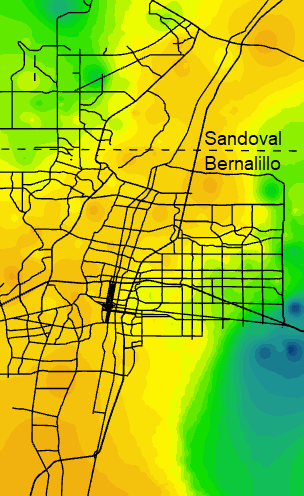 |
In 2018, portions of Rio Rancho and eastern Albuquerque received as much as 8 to 10 inches of rainfall, and even up to 14 inches around the Four Hills community in southeast Albuquerque. Few deluges were noted this season, rather, a few hundredths or a few tenths were noted when it rained. There were exceptions though, and those exceptions typically resulted in flash flooding. Some of the worst flash flooding was observed in Rio Rancho around the Enchanted Hills area on July 5th. Between 2 and 2.25 inches of rain fell between 530 pm and 630 pm. Several roads were flooded and others had mud and rocks washed over them. Several roads were closed, and a couple vehicles were inundated by flood waters. One motorist had to be rescued from their vehicle. On July 23rd, this area was hit again by heavy rainfall and flash flooding. Two other flash flooding events were noted across the Albuquerque Metro area. One occurred on July 26th around Central and 1st Street in Albuquerque where a fire truck had to be rescued from the floodwaters. The other occurred on August 22nd, again in Rio Rancho, but this time west of Unser. A very strong storm developed on the leading edge of two outflow boundaries over northwest Rio Rancho then trained over the area for over an hour. Rainfall rates approached 3 inches per hour. |
||||||||||||||||||
| 2018 | |||||||||||||||||||
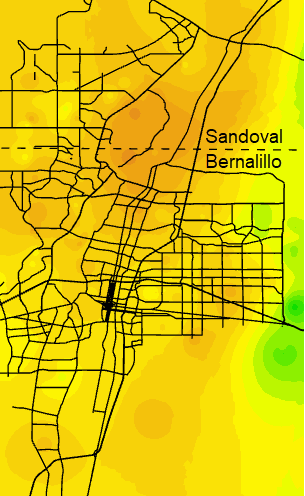 |
In 2017, most reporting stations received between 3 and 7 inches of rainfall, though a few spots received a little more! These totals would have been at least an inch or two lower without the last few days of September. 5.02" of precipitation fell at the Albuquerque Sunport. The biggest calendar day rain total at the Sunport was 0.80" on September 27th closely followed by the day after with 0.78". Following behind these days, the highest calendar day totals included 0.48" on June 26th, 0.46" on August 29th, and 0.44" on September 30th. Rain seemed to like the end of each month this year. The precipitation total for the four days at the end of September was 2.10", or approximately 42% of the precipitation that fell this monsoon. That's right, almost half of this year's monsoon rainfall in just four days! And not just four days, four consecutive days, at the end of the season! Normal monsoon rainfall in Albuquerque totals 4.61 inches. The 2017 total of 5.02" at the Sunport was 109% of normal. The Albuquerque Valley received 6.19" of rain this season. Last year, only 4.14" of rain was recorded. Normal rainfall for the valley during the monsoon is 4.78". The Albuquerque Foothills received 7.21" of rain this year. Last year, the foothills received approximately 5.72". Normal precipitation for the June 15 through September 30th period is 7.23".
|
||||||||||||||||||
| 2017 | |||||||||||||||||||
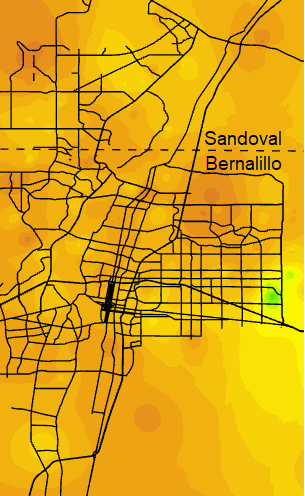 |
In 2016, 3.09 inches of precipitation fell at the Albuquerque Sunport. This is almost two inches shy of the 2015 total and is also well below climatological normals. Not all locations across Albuquerque saw this kind of paltry precipitation, but there were some, and they were scattered across the metro. Some of the obvious areas that saw these lower precipitation totals included portions of the northeast heights and western Rio Rancho. Meanwhile, the light green splotch across the southeast side of Albuquerque north of Four Hills shows where the biggest precipitation totals were this year. Though the seasonal total was above 5.5 inches, between 2 and 2.5 inches of that fell on August 4th, when very heavy rain fell for almost two hours. Fortunately, no significant flooding was observed with those storms. Nearly two inches of rain fell on portions of northwest Albuquerque and portions of southern Rio Rancho during the early evening of July 29th. Then the following day, over an inch of rain fell across south central Albuquerque, near and just south and east of UNM. The intersection at Silver and Yale as well as the Lomas and Carlisle intersection were closed due to flooding on July 30th. |
||||||||||||||||||
| 2016 | |||||||||||||||||||
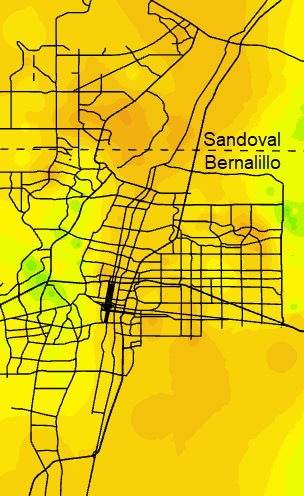 |
In 2015, most areas saw above normal precipitation. Wetter parts of the Metro included the westside as well as portions of the foothills. Most areas along and west of the Rio Grande in Bernalillo County received between 5.5 and 7.5 inches of rain as did the foothills. Rio Rancho was among the driest area in the metro with most locales reporting less than 5 inches of rain. |
||||||||||||||||||
| 2015 | |||||||||||||||||||
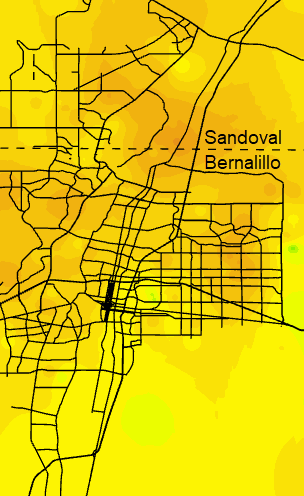 |
Precipitation amounts for 2014 were very similar to 2015, but different areas saw the greater amounts. Wetter parts of the Albuquerque Metro in 2014 were the UNM area, which was due to between 2.50 and 2.80 inches of rain falling in a two hour period on the night of August 1st. Season totals for the UNM area were between 6 and 7 inches of rain. The foothills were again one of the wetter spots, but interestingly, Rio Rancho was again one of the driest areas. |
||||||||||||||||||
| 2014 | |||||||||||||||||||
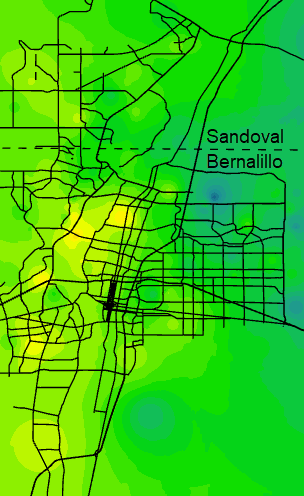 |
Using the same scale as above, it is easy to see that the 2013 Monsoon was a wet one. Everyone in the metro area received over 5 inches of rain, and some areas received over 10! The rain was a welcome sight for many, though in most cases, the rain came faster than what soils could absorb. The enhanced area of precipitation totals, ranging from 10 to 12 inches across the northeast heights, largely stemmed from the back-to-back thunderstorm events on July 26th, where some calendar day totals exceeded 4 to 5 inches. Perhaps more notably, was the week-long stretch of rainfall in September, which accounted for almost half of Albuquerque's Monsoon precipitation. For the Albuquerque Sunport, 3.14 inches of rain was recorded during these 7 days, though some areas in the Foothills and in Rio Rancho received over 5 inches! Even only using the 3.14 inches at the official station, this was the wettest 7-day stretch since June 1933! |
||||||||||||||||||
| 2013 | |||||||||||||||||||
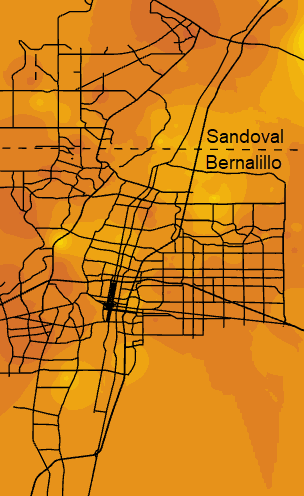 |
In 2012, we thought it would never rain again. Ok, that's a bit dramatic, but we were desperate for rainfall. In fact, you'll notice that for many areas, the week-long stretch mentioned above in 2013 provided more rainfall than all of the 2012 Monsoon Season for most of the metro area. In 2012, the Albuquerque Sunport received 3.36 inches for the entire season. Going back even further, in 2011 the Albuquerque Sunport measured only 1.72 inches. 2011 was the 5th driest Monsoon Season on record. What a difference a few years makes! |
||||||||||||||||||
| 2012 | |||||||||||||||||||
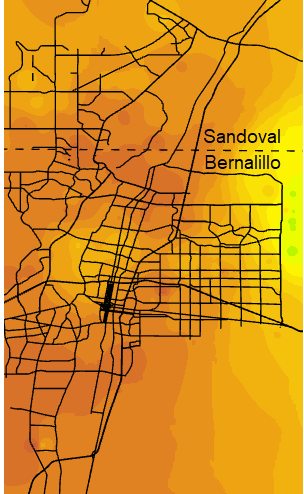 |
In 2011, there was quite the gradient of precipitation from western portions of Albuquerque to the foothills. While the foothills received close to 6 inches of rainfall, other portions of the metro struggled to muster up 3 inches. |
||||||||||||||||||
| 2011 | |||||||||||||||||||
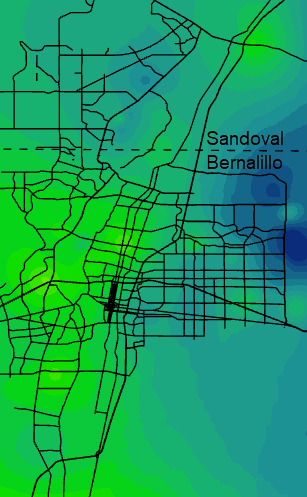 |
Many people wondered if the 2013 totals would reach the totals from 2006. Though close, they didn't quite get there. The map to the left shows the precipitation distribution across the metro area from 2006 using the same scale as above. 2006 still ranks as the wettest Monsoon on record, with 9.42 inches measured at the Albuquerque Sunport. |
||||||||||||||||||
| 2006 | |||||||||||||||||||